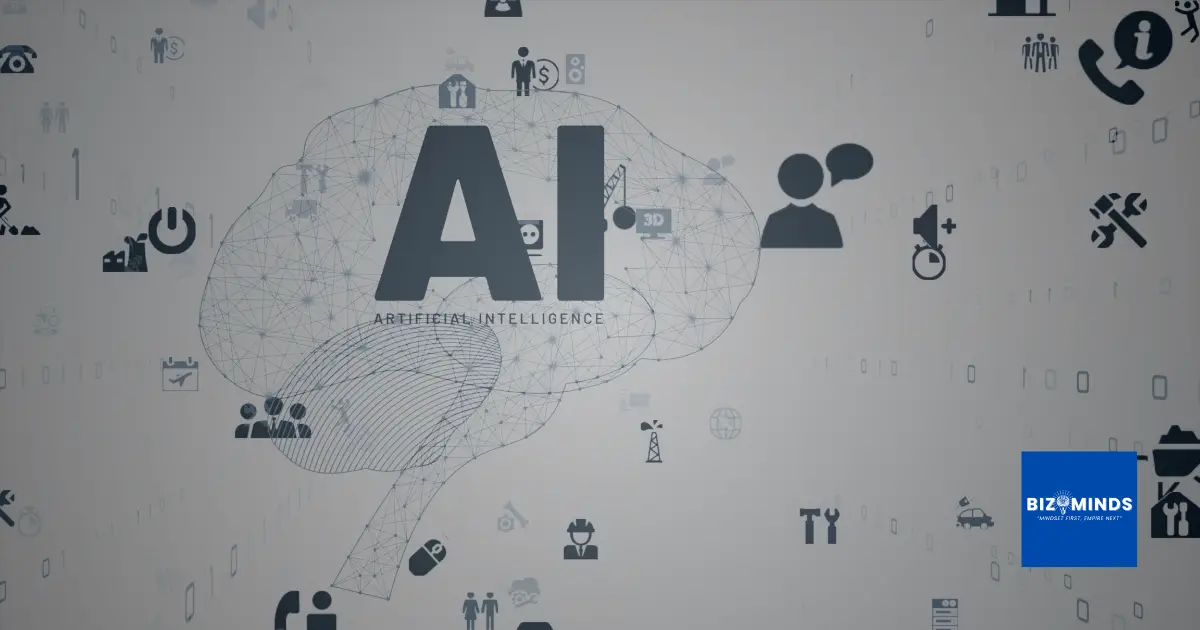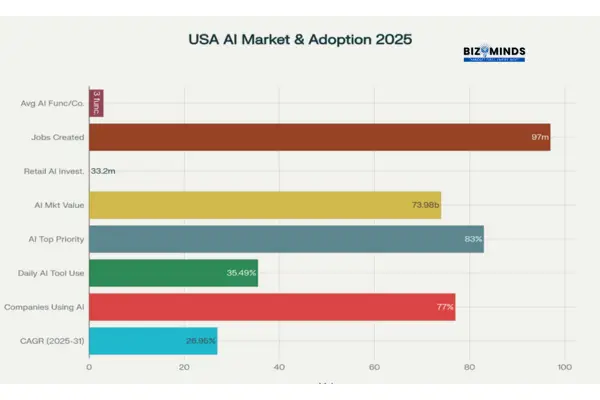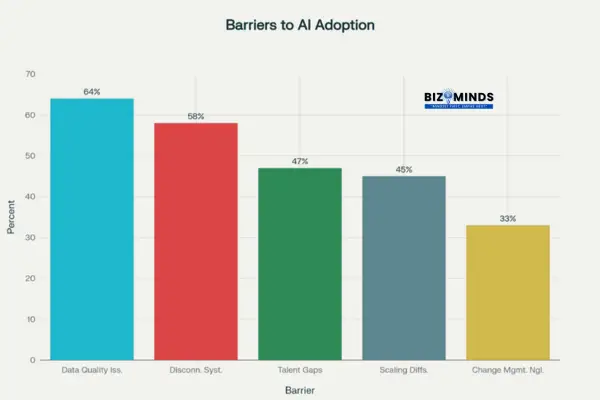

The Role of AI in Business: Emerging Trends to Track in 2025
Picture this: It’s Monday morning, and Sarah, the CFO of a mid-sized manufacturing company in Ohio, starts her day not by sifting through spreadsheets, but by reviewing insights that her AI assistant has already compiled overnight. Market trends, supply chain risks, cash flow projections—all analyzed, prioritized, and presented before she’s even had her first cup of coffee. This isn’t science fiction. This is the reality for thousands of American business leaders in 2025.
The transformation happening in American boardrooms isn’t gradual—it’s explosive. For American businesses, 2025 represents a watershed moment where the US AI market, now valued at $73.98 billion and growing at 26.95% annually, isn’t just expanding—it’s fundamentally reshaping how companies compete and create value. Over 99% of Fortune 500 companies have already adopted AI in some capacity, while AI in business adoption has leaped to 72%, a dramatic jump that signals we’ve passed the tipping point. Yet here’s what keeps America’s most successful CEOs up at night: it’s not the fear of AI itself—it’s the fear of not moving fast enough while 83% of companies claim AI is a top priority, the gap between intention and execution remains vast.
This transformation isn’t just about algorithms and data centers—it’s about people and competitive survival. When 92.1% of businesses report measurable results from AI in business and companies like Amazon generate $4.90 in economic value for every dollar spent on AI solutions, standing still becomes moving backward. The projection that 97 million people will work in the AI space by the end of 2025 represents more than job creation—it signals a fundamental shift where humans and machines collaborate in ways that seemed impossible just years ago. The moment of choice is here. The question isn’t whether AI will transform American business—it already has. The question is whether your business will be part of that transformation, or become part of its history.
The artificial intelligence revolution isn’t coming—it’s here. For American companies, 2025 represents a pivotal moment as AI in Business shifts from being experimental to becoming core infrastructure. Walk into any American boardroom today, and you’ll hear a familiar refrain: “How do we leverage AI to stay competitive?” When it comes to AI in Business, the real question is no longer if companies should adopt it, but how quickly and effectively they can integrate it into their core operations. With the US AI market valued at $73.98 billion and growing at a staggering 26.95% annually, American enterprises are racing to harness AI’s transformative power before their competitors do.

AI in Business Adoption and Market Stats in the USA for 2025
Yet beneath this enthusiasm lies a complex reality. While 77% of American companies are already using AI in some capacity, and 83% consider it a top strategic priority, many are still struggling to move beyond pilot projects to realize measurable business value. The companies that succeed in 2025 will be those that understand AI isn’t just about technology—it’s about fundamentally reimagining how work gets done.
The Rise of Agentic AI in Business: From Digital Tools to Digital Workforce
The Game-Changing Shift Beyond Chatbots
Remember when your biggest AI worry was whether ChatGPT would write a decent email? Those days feel quaint now. American businesses are witnessing the emergence of agentic AI—autonomous systems that don’t just respond to commands but proactively identify problems, make decisions, and take action.
Think of it this way: traditional AI was like having a very smart intern who could answer questions brilliantly but needed constant supervision. Agentic AI is like hiring an experienced professional who understands your business, anticipates needs, and gets things done independently.
Real American Success Stories of AI in Business
Take Walmart, America’s retail giant. Their new generative AI-powered search isn’t just helping customers find products—it’s understanding context like “planning a birthday party for a 7-year-old” and curating complete solutions. The result? A 22% boost in e-commerce growth that executives directly attribute to their AI initiatives.
Meanwhile, Microsoft has deployed Copilot across its global workforce, with employees saving 30-60 minutes daily. But here’s what makes this agentic: the AI doesn’t just help with individual tasks—it orchestrates workflows, schedules meetings, and even predicts project bottlenecks before they happen.
The Investment Surge
Global spending on AI in Business agents is forecast to exceed $47 billion by 2030, with U.S. companies taking the lead. But smart executives aren’t just throwing money at the latest AI tools—they’re building multi-agent workflows where specialized AI systems collaborate like departments in a company.
JPMorgan Chase exemplifies this approach, using AI agents for fraud detection, risk assessment, and customer service simultaneously, achieving an 89% client retention rate.
| Company | AI initiative | ROI/Impact | Impl Scale |
| Walmart | Gen AI Search & Supply | 22% e-com growth | Enterprise-wide |
| Microsoft | Microsoft 365 Copilot | 30-60 min saved | Global rollout |
| Amazon | AWS AI Services | 3.45 % | Platform-wide |
| JPMorgan | Fraud Detect & Analytics | 89% retention | Core ops |
| Kroger | Digital Twins & Checkout | 50% faster checkout | Chain-wide |
Fortune 500 Companies: Real-World AI Implementation Examples and Measurable Business Impact
Each agent has a specific role, but together they create a comprehensive intelligence network that human teams alone could never match.
Advanced AI in Business Reasoning: From Pattern Recognition to Strategic Thinking
The Breakthrough That Changes Everything
Here’s what keeps American CEOs awake at night: their competitors aren’t just using AI that recognizes patterns—they’re using AI that can reason, plan, and strategize. OpenAI’s recent breakthrough with reasoning models like o1 represents a quantum leap from simple prediction to genuine problem-solving.
This isn’t academic theory. These reasoning systems are scoring in the 89th percentile on competitive programming challenges and solving complex mathematical problems that previously required human experts. For American businesses, this means AI can now tackle strategic challenges that were unthinkable just months ago.
Business Applications That Matter for AI in Business
Consider how this plays out in real American companies:
Financial Services: AI reasoning systems at major Wall Street firms are now conducting comprehensive risk assessments that factor in geopolitical events, market sentiment, and regulatory changes simultaneously. They’re not just crunching numbers—they’re developing investment strategies.
Healthcare: American hospitals are using reasoning AI to analyze patient symptoms, medical history, and treatment outcomes to recommend personalized care plans that human doctors then refine and approve.
Legal: Top law firms are deploying reasoning AI to analyze complex contracts, predict litigation outcomes, and even draft legal strategies—tasks that require genuine analytical thinking, not just document search.
Manufacturing: Companies like General Electric use reasoning AI to predict equipment failures by analyzing not just sensor data, but also maintenance schedules, operator behavior, and supply chain constraints.
The competitive advantage is clear: while your competitors are using AI to automate routine tasks, companies with reasoning AI are using it to outthink the competition.
Multimodal AI Integration: Processing the Full Business Context
Beyond the Limitations of Text-Only AI
Traditional AI in business was like having a brilliant advisor who could only read—powerful, but limited. Multimodal AI is like having an advisor who can see, hear, read, and understand video, giving them the complete picture your business operates in.
American companies are discovering that business decisions shouldn’t be made in data silos. When Walmart’s multimodal AI combines text from customer reviews, images of products, video demonstrations, and transaction data, it doesn’t just recommend products—it understands customer intent in ways that purely text-based systems never could.
Industry Applications Driving Results
Retail Revolution:
Target uses multimodal AI to analyze in-store camera feeds, inventory databases, and customer behavior patterns simultaneously. The result? Dynamic pricing and inventory management that responds to real-time store conditions.
Financial Services:
American Express employs multimodal AI that examines transaction data, merchant photos, customer communication, and even social media activity to detect fraud with unprecedented accuracy. By processing multiple data types, they’ve reduced false positives by over 30% while catching sophisticated fraud schemes.
Manufacturing Excellence:
Ford’s multimodal AI systems monitor production line cameras, sensor data, maintenance logs, and worker reports to predict quality issues before they occur. This comprehensive approach has improved their defect detection rates by 40%.
Insurance Innovation:
State Farm uses multimodal AI to process claim reports, damage photos, customer calls, and weather data to accelerate claims processing by 30% while reducing fraudulent claims by 22%.
The business impact is profound:
Companies using multimodal AI report more contextual insights leading to better business decisions across every department.
Enterprise AI Governance in Business: From Experimental to Strategic
The Maturity Gap Crisis
Here’s a sobering reality check for American businesses: while 80% have 50+ generative AI use cases in their pipeline, very few have successfully moved these from pilot to production. The culprit? Inadequate governance frameworks that treat AI like a science experiment rather than critical business infrastructure.
The New Competitive Advantage
Forward-thinking American companies are discovering that AI governance isn’t a compliance burden—it’s a competitive weapon. Companies with robust governance frameworks are deploying AI 56% faster than their peers and seeing significantly higher success rates.
Consider Microsoft’s approach: they’ve built comprehensive governance that enables rapid innovation while maintaining strict oversight. Their framework includes risk tiering for different AI applications, automated monitoring systems, and clear accountability structures. This isn’t slowing them down—it’s enabling them to scale AI across their entire global organization confidently.
Frameworks That Work
Leading American enterprises are adopting proven governance models:
McKinsey’s Safe and Fast Deployment:
Cross-functional steering groups coordinate AI efforts while implementing tiered controls for different risk levels.
PwC’s Lifecycle Governance:
Compliance is built into every stage of AI development, from conception through deployment and monitoring.
Deloitte’s Strategic Board Oversight:
AI governance becomes a board-level responsibility with clear roles for executives, committees, and operational teams.
The companies getting this right are seeing 70-75% positive ROI on their AI investments, compared to industry averages around 50%.
Workforce Transformation: AI as Collaborative Partner, Not Replacement
The Human Reality of AI Transformation
Let’s address the elephant in the room: American workers are worried about AI taking their jobs. But the data tells a more nuanced story that smart business leaders need to understand. By 2025, 85 million jobs could disappear due to AI, but the technology will also foster 97 million fresh roles, leaving a surplus of 12 million positions.
The Skills Premium Revolution
Here’s what American executives need to know: AI-savvy workers command a 56% wage premium. Companies that invest in upskilling their workforce aren’t just being socially responsible—they’re building competitive advantages that can’t be easily replicated.
Productivity Gains That Matter
Real American companies are seeing transformative results:
Junior Staff Acceleration:
New employees using AI tools show 20-30% productivity increases, allowing them to contribute meaningfully much faster than traditional training alone.
Senior Professional Enhancement:
Experienced workers using AI report 10-15% productivity gains while focusing on higher-value strategic work.
Cross-Training Revolution:
AI is enabling American workers to develop skills across multiple domains, creating more versatile and valuable team members.
Implementation Strategies That Work
Successful American companies are following specific patterns:
Leadership Support:
Clear integration strategies where executives model AI adoption and provide comprehensive training resources.
Human-AI Collaboration:
Rather than replacement scenarios, these companies design workflows where AI enhances human capabilities—AI handles data processing while humans provide judgment, creativity, and relationship management.
Change Management Priority:
Only 33% of companies prioritize training and change management, but those that do see dramatically higher adoption rates and employee satisfaction.
The message is clear:
companies that help their people thrive alongside AI will build stronger, more capable organizations than those that simply automate away human roles.
Industry-Specific AI Applications: Where American Companies Lead
Financial Services: The AI-Native Advantage in AI in Business
American financial institutions are leading a global transformation. AI-native fintech startups are disrupting traditional banking while established players like JPMorgan Chase are revolutionizing their operations.
JPMorgan’s approach is particularly instructive: they’re using AI across fraud detection, risk management, and customer service simultaneously. Their AI systems process millions of transactions daily, flagging suspicious activity with precision rates exceeding 95% while reducing false positives that frustrate customers.
Healthcare: Accelerating American Innovation through AI in Business
The American healthcare system, despite its complexities, is seeing remarkable AI adoption. Drug discovery timelines that traditionally took 10-15 years are being compressed to 3-5 years through AI-powered research.
American hospitals are using AI for diagnostic assistance and personalized treatment plans. The Cleveland Clinic, for example, uses AI to analyze patient data and predict which treatments will be most effective for individual patients, improving outcomes while reducing costs.
Manufacturing: The Smart Factory Revolution Powered by AI in Business
American manufacturers are combining AI with traditional industrial expertise to create “smart factories.” General Electric’s approach exemplifies this: their AI systems provide predictive maintenance, quality control, and supply chain optimization that has reduced downtime by 20% across their manufacturing facilities.
Retail: Personalizing the American Shopping Experience with AI in Business
Beyond Walmart’s success, American retailers are using AI in business for dynamic pricing, inventory management, and customer experience enhancement. Target’s AI systems analyze shopping patterns to optimize store layouts and product placement, resulting in increased sales and improved customer satisfaction.
Professional Services: Knowledge Mining Enabled by AI in Business
American law firms and consulting companies are using AI for document analysis, compliance automation, and knowledge mining. These applications help professionals focus on strategic thinking while AI handles information processing and initial analysis.
The ROI Reality Check: Measuring Success in American Businesses
Success Metrics That Matter
The numbers tell a compelling story about AI’s business impact in America. 74% of companies report their AI initiatives meet or exceed ROI targets, but the real leaders are seeing even more dramatic results.
High-Performer Advantages
The top 20% of AI adopters are seeing returns exceeding 30% on their advanced AI initiatives. What separates these companies? They’re not just implementing AI tools—they’re fundamentally redesigning business processes around AI capabilities.
Investment Correlation Success
Companies spending more than 5% of their IT budget on AI consistently see 70-75% positive ROI. This suggests that half-hearted AI adoption doesn’t work—organizations need to make meaningful commitments to see meaningful returns.
Time to Value
Most successful AI projects deliver measurable returns within 18 months, but the highest-performing companies see initial benefits much sooner. The key is starting with high-impact, well-defined use cases rather than trying to boil the ocean.
The $3.50 Rule
On average, American companies see $3.50 in value for every $1 spent on AI. However, this average masks significant variation—companies with strong governance, clear strategy, and employee buy-in often see returns of 5:1 or higher.
Implementation AI in Business Challenges: What American Companies Must Overcome
The Top Barriers Holding Back Success for AI in Business
Despite the impressive potential, American companies face real challenges in AI adoption:
Data Quality Crisis: 64% cite data quality issues as their primary barrier. AI is only as good as the data it’s trained on, and many companies discover their data isn’t AI-ready.
Disconnected Systems: 58% struggle with disconnected systems that prevent comprehensive AI deployment. Legacy IT infrastructure often can’t support modern AI applications without significant upgrades.
Talent Gaps: Finding people who understand both AI technology and business applications remains challenging, especially outside major tech hubs.
Scaling Difficulties: Moving from successful pilots to enterprise-wide deployment proves harder than expected for most organizations.
Change Management Neglect: Only 33% prioritize training and change management, yet this is often the difference between success and failure.

Top Barriers to AI in business Adoption in American Companies (2025)
Solutions That Work
Leading American companies are overcoming these challenges through:
Infrastructure Investment: Building AI-ready systems that can scale as needs grow.
People-First Approach: Comprehensive training programs and AI champions who help their colleagues adapt to new tools.
Comprehensive Strategy: Rather than piecemeal adoption, successful companies develop enterprise-wide AI strategies with clear governance and measurable objectives.
Looking Ahead: Preparing for America’s AI in Business-First Future
Strategic Recommendations for American Leaders
As we look toward the remainder of 2025 and beyond, American business leaders need to make critical decisions now:
Build AI-Ready Infrastructure: The Foundation of AI in Business Success
For AI in Business to deliver real value, companies must go beyond adopting new tools—they need scalable, secure, and AI-ready infrastructure. This means creating systems that prioritize data governance, uphold strict security standards, and ensure seamless integration across the organization. Firms that build this foundation today will be the ones thriving tomorrow.
Focus on Data Quality: The Key to Unlocking AI in Business
In AI in Business, the power of algorithms depends on the strength of the data behind them. Before adopting advanced AI in business, companies must invest in data quality initiatives—clean, consistent, and reliable data. A solid data foundation ensures that AI insights are accurate, actionable, and impactful.
Invest in People: Why Human Capital Drives AI in Business Success
The human role is central to AI in Business transformation. Companies that invest in employee training and effective change management consistently see stronger, longer‑term results.
Competitive Positioning Through Early Adoption
Early adopters are gaining sustainable advantages that will be difficult for competitors to overcome. The network effects of AI in business—where more data leads to better models, which attract more users, generating more data—create powerful moats around successful implementations.
Timeline Expectations
2025 is the tipping point for widespread AI adoption in American businesses. Companies that haven’t started their AI transformation risk being left behind as the technology becomes table stakes rather than competitive advantage.
The Imperative for Action: Why American Companies Can’t Wait
The Window of Opportunity
The AI in business transformation is accelerating rapidly. American companies that delay serious AI adoption risk finding themselves permanently disadvantaged as competitors build AI-native capabilities that are difficult to replicate.
Success Factors for American Businesses
The companies that will thrive in America’s AIin business-first future share common characteristics:
Strategic Vision: They see AI in business as fundamental corporate infrastructure, not just productivity tools.
Proper Governance: They’ve built frameworks that enable innovation while managing risk.
Human-Centered Implementation: They recognize that AI in business success depends on people, not just technology.
The choice facing American business leaders isn’t whether to adopt AI—it’s whether to lead the transformation or be transformed by it. In a market where AI adoption is growing 20% year-over-year and the technology is becoming more capable every month, standing still is moving backward.
The Real Risk
The biggest risk American companies face is not AI itself — it is the risk of not adopting AI fast enough. As AI becomes business infrastructure rather than competitive advantage, companies without comprehensive AI capabilities will find themselves unable to compete on cost, speed, or innovation.
The AI in business revolution is here. The question isn’t what’s next for AI in business—it’s whether your business will be part of AI’s next chapter. The companies that answer that question decisively and act boldly in 2025 will be the ones writing the success stories of 2030.
Conclusion: The Time for AI in Business Transformation is now
As we stand at the crossroads of 2025, American businesses face a defining moment that will determine their relevance for decades to come. The data is unequivocal: 68% of CEOs report that AI in business changes aspects of their business they consider core, while 61% believe competitive advantage depends on who has the most advanced generative AI. This isn’t hyperbole—it’s the new reality of American commerce. The companies that recognize AI as fundamental business infrastructure, not merely a productivity tool, are already pulling ahead of their competitors in measurable ways. Those still treating AI as an optional enhancement risk becoming cautionary tales of missed opportunities.
The window for gradual adoption of AI in Business is closing fast. In 2025, 89% of executives are advancing Gen AI initiatives—a sharp rise from just 16% prioritizing AI transformation in 2024—showing that the pace of change has far outstripped leadership expectations. American businesses can no longer afford the luxury of extended pilot programs or cautious experimentation. The market leaders of tomorrow are being determined today by organizations that understand AI in business transformation requires thinking like a startup: being willing to break with the past, embrace creative destruction, and continuously reinvent their operations. This means making bold investments in AI-ready infrastructure, comprehensive workforce development, and governance frameworks that enable rapid innovation while managing risk.
In America’s shift to AI in Business, human talent is still the ultimate differentiator. While AI agents and autonomous systems handle increasingly complex tasks, the most successful American companies are discovering that AI’s greatest power lies in co-intelligence—the seamless collaboration between human creativity and artificial intelligence capabilities. Organizations that invest in upskilling their workforce, foster AI literacy throughout their ranks, and design workflows that amplify human strengths through AI assistance are building sustainable competitive advantages. The projection that 97 million people will work in the AI space by 2025 represents more than job creation—it signals a fundamental shift toward human-AI partnerships that multiply organizational capability in ways previously unimaginable.
The choice confronting American business leaders isn’t whether to embrace AI—that decision has been made by market forces beyond any individual company’s control. The choice is whether to lead the transformation or be transformed by it. As almost 90% of business leaders now consider AI fundamental to their company’s strategy, and the global AI market races toward $826.70 billion by 2030, the companies that act decisively in 2025 will write the success stories of 2030. The artificial intelligence revolution isn’t coming to American business—it’s already here. The question that will define your company’s future is simple: Will you be part of AI’s next chapter, or will your competitors write it without you?








